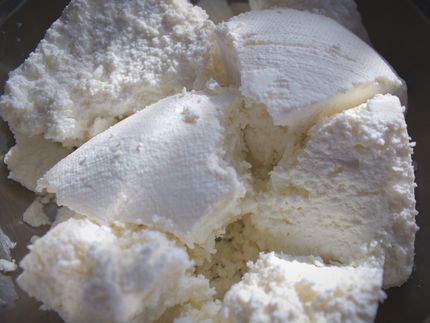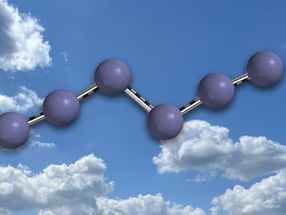Intentional stress in the habitat of Latilactobacillus sakei
Cream cheese alternatives: not only vegan, but also balanced
Food technologists are researching cream cheese alternatives that contain less sugar and fat and no additives, but are rich in plant proteins.
Julia Matysek and Robert Sevenich spread stress using Latilactobacillus sakei. Quite deliberately. In a targeted manner. Using pulsed electric fields and ultrasound, they create an environment in which it is uncomfortable for the lactic acid bacterium. Latilactobacillus sakei defends itself against this and produces exopolysaccharides. And this is precisely the "substance" that the two scientists are after.
Julia Matysek and Dr.-Ing. Robert Sevenich are conducting research at the TU Department of Food Biotechnology and Process Engineering under the direction of Prof. Dr.-Ing. Cornelia Rauh together with scientists from the Belgian University KU Leuven to create vegan cream cheese alternatives and spreads that are rich in plant proteins but do not require hydrocolloids, i.e. additives that must be declared, and still have a creamy texture. And for this they need exopolysaccharides. Products without additives are known in the food industry as "clean label products" and are increasingly in demand by consumers.
At the expense of nutritional values
The background to their research is that the vegan cream cheese alternatives and spreads based on almonds, oats or peas that are currently available on the market are creamy and spreadable. However, creaminess and taste come at the expense of nutritional value. "They contain a lot of carbohydrates in the form of short-chain sugar, a lot of fat - vegetable fat, in fact - and many declarable additives such as E 330, E 440, E 509, E 511. The additives bind water and have a stabilizing effect, so that the spread retains a creamy texture. Together with sugar and coconut or palm oil, they ensure the right mouthfeel and prevent the ingredients from separating. On average, vegan spreads currently contain ten grams of sugar per 100 grams and 25 grams of fat. Vegetable proteins, on the other hand, only make up a fraction of the recipe in these vegan spreads," says food technologist Julia Matysek. So vegan, but not yet particularly balanced.
Desirable: the tart note becomes more present
Julia Matysek and Dr.-Ing. Robert Sevenich want to change that. Their starting product is a home-made plant milk. This consists of hemp, pea and potato proteins and has a significantly lower sugar content. Sugar cannot be completely dispensed with, as it is needed as a "nutrient" for fermentation. The plant milk produced in this way is inoculated with the lactic acid bacterium Latilactobacillus sakei, or L. sakei for short, for fermentation. Why is this done? The bacterium can form exopolysaccharides (EPS) during fermentation, which make the spreads creamy and spreadable. This means that the often added sugar and high fat content in vegan cream cheese alternatives and spreads can be replaced or at least reduced.
"The fermentation also means that the beany taste of the plant proteins fades into the background and the sour note, as we know it from animal cheese, becomes present. However, as the fermentation of plant proteins is difficult in contrast to the fermentation of cow's, sheep's or goat's milk, vegan cream cheese alternatives have so far been artificially acidified by adding acidifying agents. However, we are looking for a natural way. Our colleagues in Leuven have succeeded in identifying the lactic acid bacterium L. sakei, which is able to ferment plant milk optimally with regard to the formation of EPS. A huge amount of research has gone into this," says Julia Matysek.
Protective mechanism against adverse environments
In addition to the classic method of fermentation at different temperatures, Julia Matysek and Dr. Robert Sevenich are also experimenting with two other technologies: In these, the L. sakei is stressed with pulsed electric fields (PEF) and ultrasound before fermentation, as mentioned at the beginning. Using these two innovative methods, they are investigating the influence of stressing the bacteria on their EPS formation. Their main aim is to produce a large amount of EPS in an economically viable time in order to transfer the process from laboratory to industrial scale and make it applicable for small and medium-sized companies. "In order to 'tease out' the maximum amount of EPS, we use both processes to create an environment that counteracts the optimal growth conditions of the lactic acid bacteria L. sakei in our matrix of hemp, pea and potato proteins. They become stressed and try to protect themselves by producing EPS. EPS production is therefore a protective mechanism against these adverse environments," explains Dr. Robert Sevenich.
Toolbox for SMEs
It has not yet been proven which of the three methods - fermentation with temperature variations or with upstream stressing with pulsed electric fields or ultrasound - the lactic acid bacteria L. sakei produce the most EPS. "However, we have initial indications that the PEF process could be the most suitable - firstly in terms of the quantity and quality of the EPS produced and the ability to integrate it into industrial processes," says Sevenich. "At the end of the project, we would like to provide small and medium-sized enterprises with a toolbox that provides information on which composition of protein milk and which process is most suitable for EPS production and, in terms of texture, taste and - very importantly - nutritional content, the most promising cream cheese alternatives or spreads can be produced."
The "Vegan Spreads" project is funded by the Federal Ministry for Economic Affairs and Climate Protection as part of the program to promote joint industrial research and by the Agentschap Innoveren en Ondernemen on the Belgian side.
Note: This article has been translated using a computer system without human intervention. LUMITOS offers these automatic translations to present a wider range of current news. Since this article has been translated with automatic translation, it is possible that it contains errors in vocabulary, syntax or grammar. The original article in German can be found here.































































